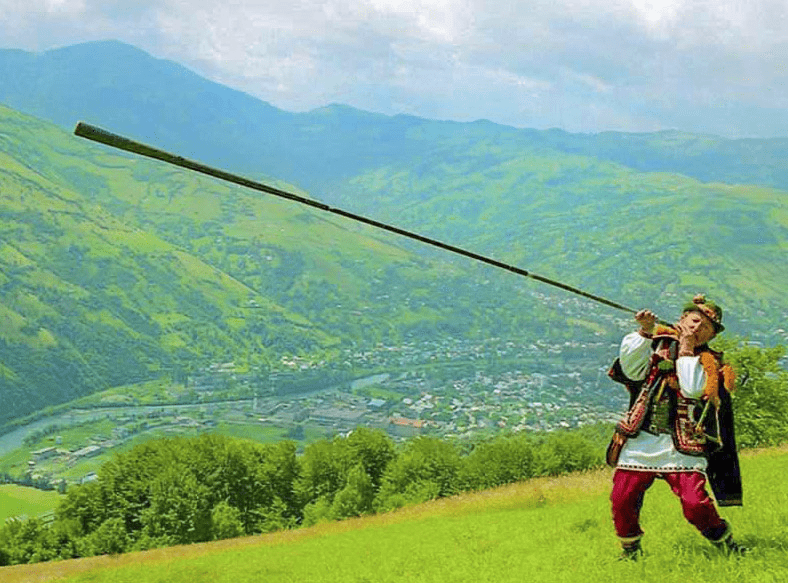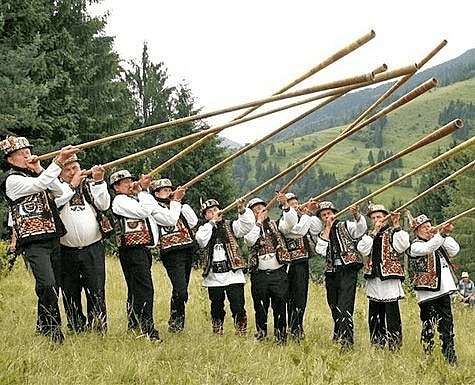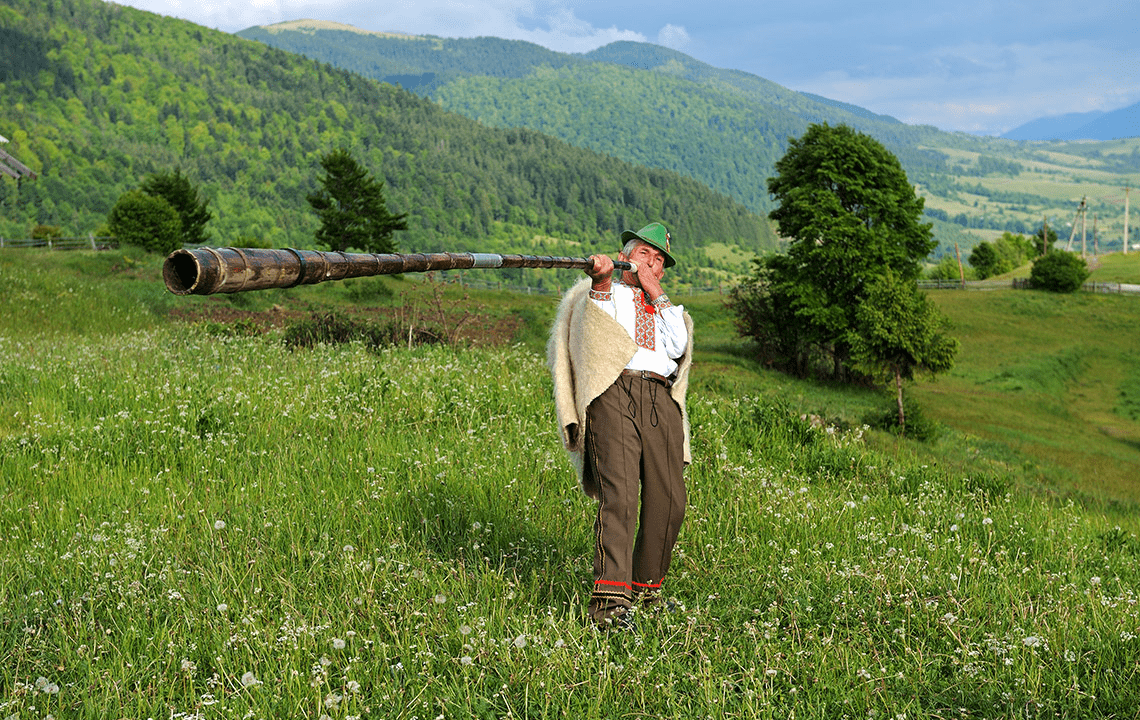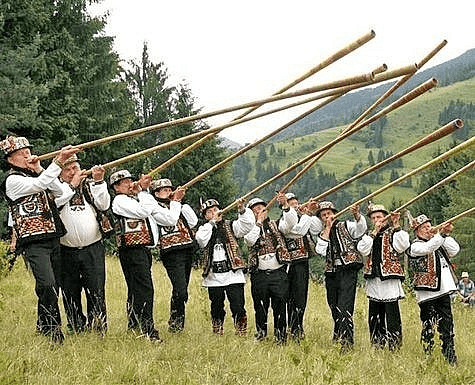Hutsul trembita — a musical instrument
13 December 2023
“The Heart of the Carpathians” is how the trembita is called by the peoples of northern and Eastern Europe. Many centuries ago, it became part of the national culture of Ukraine. The trembita is one of the longest wind instruments in the world. And it’s not just words, this fact is recorded in the Guinness Book of Records.
The trembita is used at weddings, holidays, and ceremonial events. In addition, it is often useful for shepherds who use the instrument to warn of danger.

What is a trembita?
According to the musical classification, the trembita is an embouchure wind instrument. It looks like a trumpet made of wood. The instrument produces a range of sounds up to three octaves, and their pitch is determined by how much air the trembita blows.
The trembita is 3 meters long, but you can find even larger specimens — up to 4 – 8 meters. Hutsuls play the instrument by blowing air through a narrow part of a 3 cm diameter pipe. The other part is wider.
Composition and features of trembita making
There are very few craftsmen left who specialize in making trembitas. The technology of making this musical instrument has not changed for centuries. To create it, larch or spruce is used, which is dried and prepared for processing.
It is very important for the craftsman to create a thin wall when creating the inner hole. This affects the beauty of the instrument’s sound. So, the thinner the wall, the more melodic the sound of the trembita. The optimal thickness is considered to be 3 – 7 mm.
Interestingly, no glue is used for its manufacture. The two halves of the instrument are connected with a ring of spruce branches, and the body is pasted over with bark at the end of production.
Although the trembita is a wind instrument, it has no valves. A narrow hole is equipped with a whistle through which the musician blows air. The whistle is made of metal or horn. The sound of each instrument is unique. It is influenced not only by the design features or length of the trembita, but also by the skill of the performer.

- Selection of wood.
- Trimming the trunk.
- Splitting the spruce along the trunk.
- Removing the core.
- Installing a mouthpiece, which is called a squeaker.
- Wrapping the cone with birch bark.
- Soaking the finished instrument in the water of a mountain river for better sound.
It may seem that making a trembita is not very difficult. However, it is not, because the process has many nuances that only masters know. For example, only thunderbolts are used for musical instruments. This is the name of a spruce tree that has been struck by lightning.
Only the power of nature can open the trunk so perfectly, and only such a tree can produce the perfect sound. In addition, there is a belief that only trembitas made of thunderbolt drive away evil spirits.
The second point that the masters take into account is that the thunderbolt must be over 120 years old. It is very difficult to find such a tree. You can wander the Carpathian forests for weeks in search of a spruce worthy of being turned into a trembita with a clear sound and positive energy. Spring harvesting is a very important time before making instruments.
Another secret from the masters is that the ax blade is driven into the trunk no deeper than 15 cm. This is truly a jewelry work, because if the trunk cannot be divided into two identical halves, the workpiece is thrown away because the trembita will not sound.
Distribution of the instrument
The trembita was widely used among the peoples of Transcarpathia, as well as Poles, Romanians, and Hungarians. In addition, trembita could be found in Polissya, but its size was much smaller and its sound was quieter. The longest musical instrument can be found in Zakarpattia.
In ancient times, Hutsul shepherds mostly used it to notify and warn local residents. For example, they would sound the trembita when flocks returned from pastures, help people who got lost to find their way around, and warn of an approaching enemy in wartime. In addition, the trembita was used at festivals, fairs, and to entertain themselves with chants while grazing cattle in the highlands.
The use of the musical instrument
Today, shepherds occasionally use the trembita on pastures. For the most part, its relevance remains in remote settlements of Western Ukraine. Today, the instrument is part of the national culture, used during performances of folk and ethnographic groups as an accompaniment to other musical instruments or on its own. Its colorful sound attracts the attention of listeners and creates interesting musical images. For example, the singer Ruslana used the trembita in her performance at the Eurovision Song Contest 2004, where she won the victory for the country. This is the best confirmation of the fact that the Hutsul trembita fits organically into modern music.
The sound of the treble clef
The sound of the trembita is produced by a special way of playing. The musician places the end of the trembita on his shoulder or chest, and then exhales air from his lungs to create the sound. The sound resonates inside the pipe and comes out strong and loud.
The unique sound of the trembita is that it differs from the sound of any other instrument. It has a deep timbre with some notes at high frequencies. The sound of the instrument can be either bright and loud or quiet and mysterious, depending on how the musician handles the instrument. Its melody can evoke a variety of emotions, from joy and delight to sadness and melancholy. In addition, it should be noted that the longest trembita can be heard for tens of kilometers around thanks to the musician’s efforts.
Where can I see the instrument?
It is an adornment of many ethnographic museums and private collections. The trembita is also sometimes passed down as an inheritance.
If tourists want to see the instrument, they can visit a fair in Ivano-Frankivsk region where instruments are sold, or you can at least try to play it. It’s frankly difficult to do, because real skill is important. This instrument contains the whole soul of the Hutsul region, which you feel when you hear real musicians playing.
Technique of playing the trembita
The following factors are important for playing the instrument:
- Breathing. In order for the instrument to produce sound, you need strong and steady breathing. It is important to control the strength and speed of inhalation and exhalation to create a melody.
- Mouth. As with all wind instruments, the mouth plays an important role in sound production. It is necessary to position the lips and tongue correctly to create a variety of timbres.
- Attack. This is the beginning of the sound. To achieve a clear and bright attack on the trembita, you need to inhale the air into the instrument strongly and sharply.
- Vibrato. This is a technique for changing the pitch of the sound. You can use different vibrato techniques on the instrument, such as finger or breathing.
- Scales and chords. To play the trembita successfully, it is important to master different techniques. This will help expand the range of the instrument and create a variety of melodies.
- Expression. The trembita is an instrument with great expressiveness. Musicians must be able to convey emotions through sound, use dynamic and tempo changes to create a special atmosphere.
Mastering the trembita takes time and practice. By following these techniques and constantly improving their skills, trembitas can create amazing melodies and give listeners unforgettable emotions.
The trembita can be heard not only in folk songs, but also in modern compositions. In addition to Ruslana’s “Wild Dances,” mentioned above, this wind instrument was used in the recording of the songs “Ukraine” by the band Skryabin, Zenit by ONUKA, and others.



